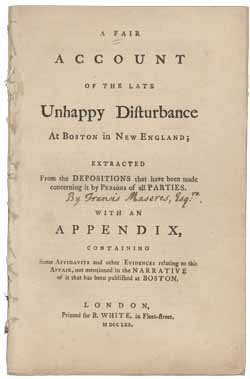A Fair Account of the Late Unhappy Disturbance at Boston in New England
To order an image, navigate to the full
display and click "request this image"
on the blue toolbar.
-
Choose an alternate description of this item written for these projects:
- Object of the Month
- Boston Massacre
- Main description
[ This description is from the project: Coming of the American Revolution ]
This pamphlet conveys a Loyalist perspective on the Boston Massacre. It contains both a narrative of the events and thirty-one testimonies collected in the days following 5 March 1770. The publication can be compared to a Patriot version of the events published as A Short Narrative of the Horrid Massacre in Boston....
Tories Strike First
In the days following 5 March, Lieutenant Colonel William Dalrymple orders his officers to collect depositions from individuals who had witnessed the events in King Street. To instill calm, British soldiers are moved from their barracks in town to Castle William, three miles out in Boston Harbor. The customs commissioners, fearing for their safety, flee Boston. On 16 March, Commissioner John Robinson sets sail for London, carrying with him a packet of military depositions. The thirty-one testimonies, which reach England before those collected by patriots, are eventually published in London, prefaced by a narrative of the event. Not surprisingly, the narrative refutes testimony published in the patriots' pamphlet, A Short Narrative of the Horrid Massacre.
Questions to Consider
1. According to the narrative published in this pamphlet, what specific incident sparked the confrontation on 5 March?
2. The authors claim that no shots could have been fired from the Customs House on the night of 5 March. What is their evidence?
Further Exploration
3. Compare the narrative of this pamphlet with the narrative published in the patriot pamphlet, A Short Narrative of the Horrid Massacre. What is the same in each narrative? What is different?
Subjects
- Maseres, Francis
- Loyalists
- Boston Massacre
- British soldiers

